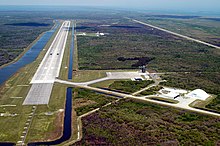Shuttle Landing Facility
| Shuttle Landing Facility | |||||||||||
|---|---|---|---|---|---|---|---|---|---|---|---|
 |
|||||||||||
| Summary | |||||||||||
| Airport type | Private | ||||||||||
| Owner | National Aeronautics & Space Administration | ||||||||||
| Location | Merritt Island, Florida | ||||||||||
| Opened | 1976 | ||||||||||
| Built | 1974 | ||||||||||
| Elevation AMSL | 10 ft / 3 m | ||||||||||
| Coordinates | 28°36′54″N 80°41′40″W / 28.615°N 80.6945°WCoordinates: 28°36′54″N 80°41′40″W / 28.615°N 80.6945°W | ||||||||||
| Runways | |||||||||||
|
|||||||||||
The Shuttle Landing Facility (SLF) (ICAO: KTTS, FAA LID: TTS) is an airport located on Merritt Island in Brevard County, Florida, USA. It is a part of the John F. Kennedy Space Center (KSC), and was used by NASA's Space Shuttle for landing until the program's end in 2011, as well as for takeoffs and landings for NASA training jets and civilian aircraft, such as the Shuttle Carrier Aircraft.
Starting in 2015, Space Florida manages and operates the facility under a 30-year lease from NASA. Private companies have been utilizing the SLF for its unique properties since 2011 and will continue to do so via Space Florida.
The Shuttle Landing Facility covers 500 acres (200 ha) and has a single runway, 15/33. It is one of the longest runways in the world, at 4,572 m (15,000 ft), and is 91.4 meters (300 ft) wide. (Despite its length, astronaut Jack R. Lousma stated that he would have preferred the runway to be "half as wide and twice as long".) Additionally, the SLF has 305 meters (1,000 ft) of paved overruns at each end. The Mate-Demate Device (MDD), for use when the shuttle was transported by the Shuttle Carrier Aircraft, was located just off the runway.
The runway is designated runway 15, or 33, depending on the direction of use. The runway surface consists of an extremely high-friction concrete strip designed to maximize the braking ability of the Space Shuttle at its high landing speed, with a paving thickness of 40.6 cm (16.0 in) at the center. It uses a grooved design to provide drainage and further increase the coefficient of friction. The original groove design was found to actually provide too much friction for the rubber used in the Shuttle's tires, causing failures during several landings. This issue was resolved by grinding down the pavement, reducing the depth of the grooves significantly.
...
Wikipedia
